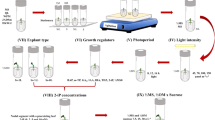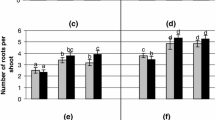Abstract
Croton floribundus Spreng., a native plant from South America, was utilized for in vitro micropropagation and phytochemical analyses. The effects of the addition of naphthaleneacetic acid and indole butyric acid, on the production of shoots and leaves, as well as volatile constituent production, were determined. The combination of naphthaleneacetic acid and indole butyric acid at a ratio of 1:1 led to the production of the maximum number of leaves and longest shoots after a 60-d subculture period. Analyses of leaf dichloromethane extracts using gas chromatography–mass spectrometry showed that monoterpenes and sesquiterpenes were the main chemical classes present in both in vivo and in vitro conditions. Use of these plant growth regulators in the medium-induced quantitative changes in the major monoterpenes (neral, geranial, limonene, and carvone). In vitro leaf extracts produced compounds such as carvone as well as a large amount of trans-β-farnesene, with the highest production of carvone (16.8%) being produced on medium supplemented with 1.0 mg L−1 naphthaleneacetic acid. These results suggested the occurrence of biotransformation reactions of limonene and farnesyl cations in culture.



Similar content being viewed by others
References
Adams RP (2001) Identification of essential oils components by gas chromatography/quadrupole mass spectroscopy. Carol Sream IL: 1st Allured Publishing Corporation, Carol Stream IL, USA
Avato P, Fortunato IM, Ruta C, D’Elia R (2005) Glandular hairs and essential oils in micropropagated plants of Salvia officinalis L. Plant Sci 169:29–36
Berry PE, Hipp AL, Wurdack KJ, Van EBW, Riina R (2005) Molecular phylogenetics of the giant genus Croton and tribe Crotoneae (Euphorbiaceae sensu stricto) using ITS and trnL-trnF sequence data. Am J Bot 92:1520–1534
Block S, Baccelli C, Tinant B, Meervelt LC, Rozenberg R, Jiwan JLH (2004) Llabrès, G.; Pauw-Gillet, M.C.; Quetin-Leclercq, J. Diterpenes from the leaves of Croton zambesicus. Phytochem 65:1165–1171
Brasil DSB, Muller AH, Guilhon GMSP, Alves CN, Andrade EHA, Silva JKR, Maia JGS (2009) Essential oil composition of Croton palanostigma Klotzsch from north Brazil. J Braz Chem Soc 20(6):1188–1192
Burger W, Huft M (1995) Family 113 Euphorbiaceae. Flora Costaricensis. Fieldiana, Bot New Series 36
Carvalho PER (2003) Espécies arbóreas brasileiras. Brasília: Embrapa Inf Tecnol 1:335–341
Castro SBR, Leal CAG, Freire FR, Carvalho DA, Oliveira DF Figueiredo HCP (2008) Antibacterial activity of plant extracts from Brazil against fish pathogenic bacteria. Braz J Microbiol 39:756–760
Chan Y, Walmsley RP (1997) Learning and understanding the Kruskal–Wallis one-way analysis-of-variance-by ranks test for differences among three or more independent groups. Phys Ther 77:1755–1762
Craveiro AA, Andrade CHS, Matos FJA, Alencar JW (1978) Anise-like flavour of Croton aff zehntneri Pax. Et Hoffm. J Agric Food Chem 26:772–773
De Carvalho C, Da Fonseca MMR (2003) Towards the bio-production of trans-carveol and carvone from limonene: induction after cell growth on limonene and toluene. Tetrahedron-Asymmetry 14:3925–3931
De-Eknamkul W, Potduang B (2003) Biosynthesis of β-sitosterol and stigmasterol in Croton sublyratus proceeds via a mixed origin of isoprene units. Phytochem 62:389–398
Dörnenburg H, Knorr D (1995) Strategies for the improvement of secondary metabolite production in plant cell cultures. Enzym Microb Technol 17:674–684
Duetz WA, Bouwmeester H, Beilen JB, Witholt B (2003) Biotransformation of limonene by bacteria, fungi, yeasts and plants. Appl Microbiol Biotechnol 61:269–277
Dunn OJ (1961) Multiple comparisons among means. J Am Stat Assoc. 56:52–64
Govaerts R, Frodin DG, Radcliffe-Smith A (2000) World Checklist and bibliography of Euphorbiaceae (and Pandaceae), 4 parts. Royal Botanic Gardens, Kew
Grzegorczyk I, Matkowski A, Wysokinska H (2007) Antioxidant activity of extracts from in vitro cultures of Salvia officinalis L. Food Chem 104:536–541
Jones K (2003) Review of Sangre de Drago (Croton lechleri). A South American tree sap in the treatment of diarrhea, inflammation, insect bites, viral infections, and wounds: traditional uses to clinical research. J Altern Complement Med 9(6):877–896
Kruskal WH, Wallis WA (1952) Use of ranks in one-criterion variance analysis. J Amer Stat Ass 47: 583–621
Lange BM, Wildung MR, Stauber EJ Sanchez C, Pouchnik D, Croteau R (2000) Probing essential oil biosynthesis and secretion by functional evaluation of expressed sequence tags from mint glandular trichomes. Proc Natl Acad Sci USA 97:2934–2939
Lima EC, Paiva R, Nogueira RC, Soares FP, Emrich EB, Silva AAN (2008) Callus induction in leaf segments of Croton urucurana Baill. Cienc Agrotec 32:17–22
Lindmark-Henriksson M, Isaksson D, Vaněk T, Valterová I, Högberg HE, Sjödin K (2004) Transformation of terpenes using a Picea abies suspension culture. J biotechnol 107:173–184
Luczkiewicz M, Glod D (2003) Callus cultures of Genista plants: in vitro material producing high amounts of isoflavones of phytoestrogenic activity. Plant Sci 165:1101–1108
Luczkiewicz M, Glod D (2005) Morphogenesis-dependent accumulation of phytoestrogens in Genista tinctoria in vitro cultures. Plant Sci 168:967–979
Marasco EK, Schmidt-Dannert C (2007) Biosynthesis of plant natural products and characterization of plant biosynthetic pathways in recombinant microorganisms. In: Verpoorte R, Alfermann AW, Johnson TS (eds) Applications of plant metabolic engineering, Springer, Dordrecht, Netherland, pp 1–43
McCaskill D, Croteau R (1997) In: Berger RG (ed) Biotechnology of aroma compounds. Advances in biochemical engineering biotechnology. Springer, Berlin
Murashige T, Skoog FA (1962) revised medium for rapid growth and bioassays with tobacco tissue cultures. Physiol Plant 15:473–497
Ofusori DA, Oluwayinka OP, Adelakun AE, Keji ST, Oluyemi KA, Adesanya OA, Jeigbe KO, Ayoka AO (2007) Evaluation of the effect of ethanolic extract of Croton zambesicus on the testes of Swiss albino mice. Afr J Biotechnol 6:2434–2438
Pinho-da-Silva L, Mendes-Maia PV, do Nascimento GTM, Cruz JS, de Morais SM, Coelho-de-Souza AN, Ralhou S, Leal-Cardoso JH (2010) Croton sonderianus essential oil samples distinctly affect rat airway smooth muscle. Phytomedicine 17:721–725
Radulovic N, Mananjaraso E, Harinantenaina L, Yoshinori A (2006) Essential oil composition of four Croton species from Madagascar and their chemotaxonomy. Bioch Syst Ecol 34:648–653
Rao RS, Ravishankar GA (2002) Plant cell cultures: chemical factories of secondary metabolites. Biotechnol Adv 20:101–153
Rubin S, Lima CSM, Bandeira JM, Ribeiro MV, Benitz LC, Peters JA, Braga EJB (2007) Reguladores de crescimento na multiplicação in vitro de Thymus vulgaris L. Rev Bras Biocienc 5:480–482
Salatino A, Salatino MLF, Negri G (2007) Traditional uses, chemistry and pharmacology of Croton species (Euphorbiaceae). J Braz Chem Soc 18:11–33
Santos PAG, Figueiredo AC, Oliveira MM, Barroso JG, Pedro LG, Deans SG, Scheffer JJC (2005) Growth and essential oil composition of hairy root cultures of Levisticum officinale W.D.J. Koch (lovage). Plant Sci 168:1089–1096
Santos-Gomes PC, Seabra RM, Fernandes-Ferreira M (2002) Phenolic antioxidant compounds produced by in vitro shoots of sage (Salvia officinalis L) Plant Sci 162:981–987
Secco RS (2004) Croton dissectistipulatus, a new species of Euphorbiaceae from Amazonian Brazil. Brittonia 56:353–356
Secco RS, Cordeiro I (2002) Notes on the first record of Croton urucurana Baill. (Euphorbiaceae) in Amazonia. Bol Mus Emilio Goeldi, Bot 18:195–201
Shibata W, Murai F, Akiyama T, Siriphol M, Matsunaga E, Morimoto H (1996) Micropropagation of Croton sublyratus Kurge. a tropical tree of medicinal importance. Plant Cell Rep 16:147–152
Shimizu Y, Imayoshi Y, Kato M, Maeda K, Iwabuchi H, Shimomura K (2009) Volatiles from leaves of field-grown plants and shoot cultures of Gynura bicolor DC. Flavour Fragr J 24:251–258
Silva S, Sato A, Lage CLS, San Gil RAS, Azevedo DA, Esquibel MA (2005) Essential oil composition of Melissa officinalis L. in vitro produced under the influence of growth regulators. J Braz Chem Soc 16:387–1390
Simões C, Mattos JCP, Sabino KCC, Caldeira de Araújo A, Coelho MGP, Albarello N, Figueiredo SFL (2006) Medicinal potencial from in vivo and acclimatized plants of Cleome rosea Vahl ex DC. (Capparaceae). Fitoterapia 77:94–99
Stockigt J, Obitz P, Falkenhagen H, Lutterbach R, Endreb S (1995) Natural products and enzymes from plant cell cultures. Plant Cell Tissue Organ Cult 43:97–109
Sudriá C, Pinol MT, Palazon J, Cusido RM, Vila R, Morales C, Bonfill M, Canigueral S (1999) Influence of plant growth regulators on the growth and essential oil content of cultured Lavandula dentata plantlets. Plant Cell Tiss Organ Cult 58:177–184
Sylvestre M, Pichette A, Longtin A, Nagaub F, Legault J (2006) Essential oil analysis and anticancer activity of leaf essential oil of Croton flavens L. from Guadeloupe. J Ethnopharmacol 103:99–102
Vanek T, Valterová I, Vankov R, Vaisar T (1999) Biotransformation of (−)-limonene using Solanum aviculare and Dioscorea deltoidea immobilized plant cells. Biotechnol Lett 21:625–628
Wagner H, Bladt S (1995) Plant drug analysis, 2nd ed. Springer, Berlin
Wungsintaweekul J, Sriyapai C, Kaewkerd S, Tewtrakul S, Kongduang D, De-Eknamkul W (2007) Establishment of Croton stellatopilosus suspension culture for geranylgeraniol production and diterpenoid biosynthesis. Z Naturforsch C 62:389–396
Acknowledgments
The first author is grateful to Capes (Instituto de Biofísica Carlos Chagas Filho, Universidade Federal do Rio de Janeiro) for providing her with a doctoral fellowship.
Author information
Authors and Affiliations
Corresponding author
Additional information
Editor: Rida A. Shibli
Rights and permissions
About this article
Cite this article
da Silva, B.O., Amaral, A.C.F., Ferreira, J.L.P. et al. Micropropagation and in vitro production of secondary metabolites of Croton floribundus Spreng.. In Vitro Cell.Dev.Biol.-Plant 49, 366–372 (2013). https://doi.org/10.1007/s11627-013-9494-z
Received:
Accepted:
Published:
Issue Date:
DOI: https://doi.org/10.1007/s11627-013-9494-z




